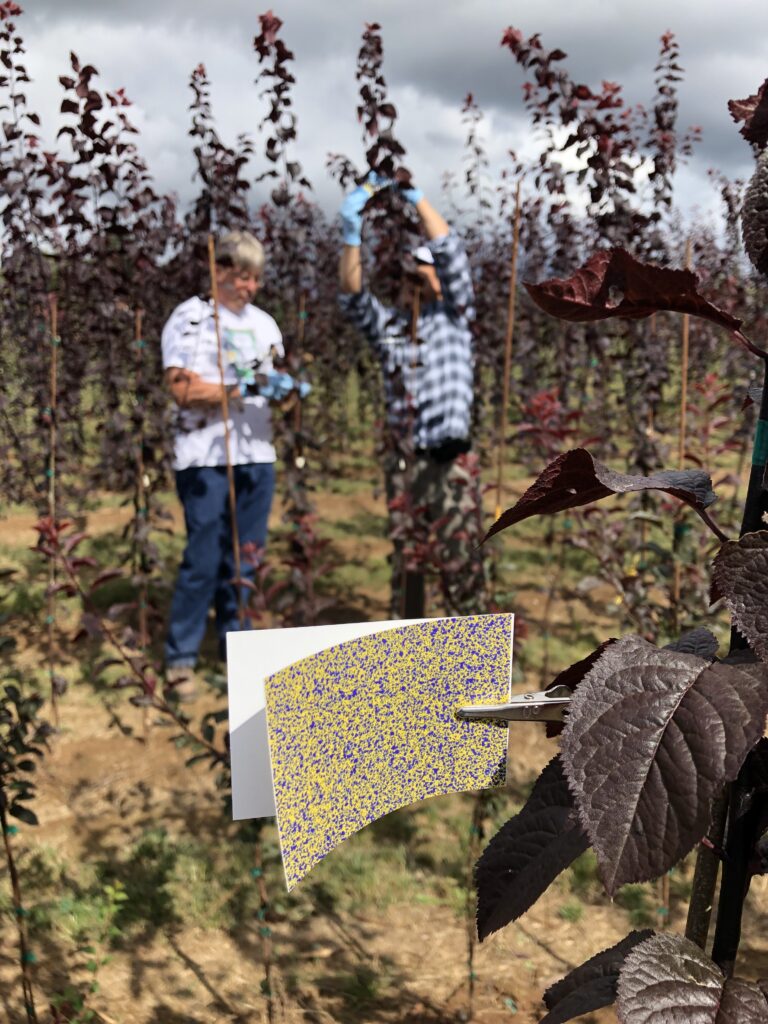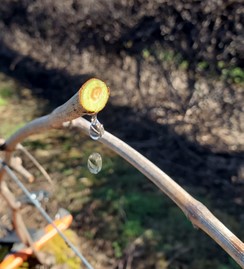Scouting for insects and areas of potential introduction early in the spring can save headaches long into the season, and it’s relatively simple with just a few inexpensive pieces of equipment. The basic starter toolkit includes just a hand lens or magnifying glass, a sheet of white paper on a clipboard, and some flagging tape to easily mark trouble spots. Easy enough, you say… but what are we looking for with these tools?


In General
Beginning early in the season and identifying where problems are most likely to emerge first will allow targeting in regular scouting and monitoring activities. Using online tools like Degree Day models for your county can also help identify when the pests are likely to move into crops based on this year’s weather data, especially when combined with information from previous years’ scouting records.
Where to Sample
When initiating scouting activities, it’s also important to consider the entire landscape of the operation. Though monitoring hotspots and suspected problem areas will help with anticipated infestations, creating sections of manageable scouting areas throughout the operation will help avoid unanticipated outbreaks as well. It’s tempting to stick to the “most affected” areas, but that limits the ability to see the whole picture. Make sure to also examine common entry ways for workers and machinery as these can act as vectors of pests.

For nurseries and greenhouse where plants are in pots for most of the season, it’s important to search not just young plants, but the media and the pots themselves. The media, if not sanitized, should be inspected for overwintering grubs, mites, and other small pests that enjoy cool, wet substrate, like springtails. In pots with plants, search the bottom of the stems where they come into contact with the soil, lightly scraping to disturb any inhabitants and observing activity. For plants that have overwintered in pots, select several representative pots to remove soil up to 12” from the stems to search for grubs like cutworms.

Pots that have overwintered plants or substrate should be checked thoroughly, inspecting under the rims of the pot (for those with a folded over lip), under the pots, and upon removal of the plant and soil if possible, inside the pot. If the entire plant, roots and soil can be gently removed to examine the inside of the pot, also check the roots and substrate for evidence of tunneling around the pot.
What to Sample
Sampling for insects isn’t like any other organisms because insects are small yet highly mobile, yet in their relatively small range can be highly exploitative. For this reason, be prepared to look for more than just insects, but also their products and proof of activities.
Look for:
- Stressed plants: otherwise healthy-looking plants with branches that appear wilted or weakened; whole plants that appear sick while others are not affected. Search the leaves, stems and plant crevices for evidence of insect presence

- Honeydew: sticky sap covering leaves or stems, appearing to have dripped from other surfaces as a result of sap-feeding insect activity on the plant – this sap may also be growing molds or other fungus secondarily

- Frass: insect poop. When insects tunnel and feed, they leave behind frass in the form of sawdust-like piles, black or brown flecks, or poop stuck to fine silken webbing in the case of silk-producing insects.

- Exuviae: the shed skins of insects, lost as the insects grow. Usually seen later in the season, but as some insects emerge from their overwintering stage, they may molt and leave their exuviae on the surface of the soil, on their host plant, or on nearby artificial structures (especially in greenhouses).

How to Sample in Early Spring
1. Beat Sheet/Tap Sample
A beat sheet is a large square sheet held under foliage while the foliage is vigorously shaken or beaten with a stick. As one can imagine, this is less reasonable for tender young nursery and greenhouse plants. However, it can be easily modified for more effective and less damaging use when scaled down to a plain white sheet of paper on a clipboard as suggested in the aforementioned toolkit. Holding the clipboard under the plant, gently tap the plant with your finger to dislodge any insects that may be attached to the plant – usually anywhere from 30-60 seconds is plenty. Using the hand lens, the insects can then be identified and counted.

2. Aspirator
These are readily available on supply websites, and can be used to gently vacuum small insects off of plants and sheets of paper for identification with a microscope, for freezing/preservation, or simply to remove the pest from the plant.

3. Berlese Funnel
If activity is observed in plant substrates, this is helpful in identifying the specific insects and arthropods present. A sample of the media is introduced into the funnel with a light/heat source above. As the sample dries and heats, the insects move deeper into the funnel, eventually falling through to the collection cup for easier preservation and identification. A soda bottle and desk lamp are sufficient for a makeshift Berlese funnel.


4. Sticky Cards
A traditional means of monitoring flying pests, use appropriate density according to location (In general, 1 card per 1,000 ft2 is standard). There are a few different types to monitor specific pests: blue cards attract mainly thrips; yellow cards attract multiple species. If you have crawling pests, you can place them on the bench overnight (when crawling insects tend to be the most active. To collect, simple cover with a piece of plastic wrap and observe insects using hand lens or magnifying glass. Things to remember: aphids have a life stage that is wingless, and thus won’t be caught on sticky cards; if natural enemies are released, REMOVE sticky cards as they will also capture these beneficial insects.


5. Potato Trap
In western Oregon where there has been a good deal of rainfall through the winter, monitoring fungus gnats is especially pressing in the early spring. Potato slices placed onto the surface of the soil/substrate is an excellent trap for fungus gnat larvae, both to monitor populations and to remove them from the soil.
6. Trap Crops
As it becomes time for pests to invade crops, early placement of trap crops and distract them from cash crops. They can also provide services as sentinel plants to warn of increasing pest populations as the season continues, as well as track phenology. Well known trap plants are:
- Tomato, eggplant, lantana or marigold for greenhouse whitefly
- Marigolds, crotons, chrysanthemums, roses, impatiens and ivy geraniums for spider mites.
- Peppers and fuchsias for aphids.
- Gerbera, verbena or chrysanthemum for thrips
Remember
Scouting for insects changes with the season, but there are things that can be done early in the year to discourage and stay on top of changing conditions. Good record keeping and persistent monitoring are the keys to success when it comes to keeping pests at bay!
































